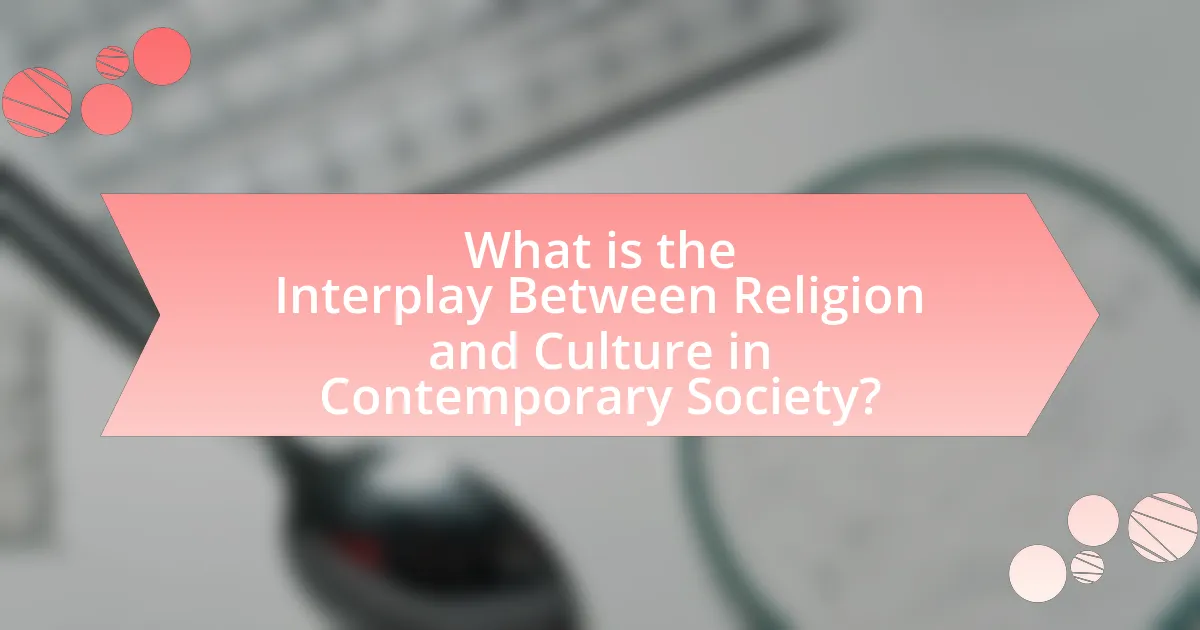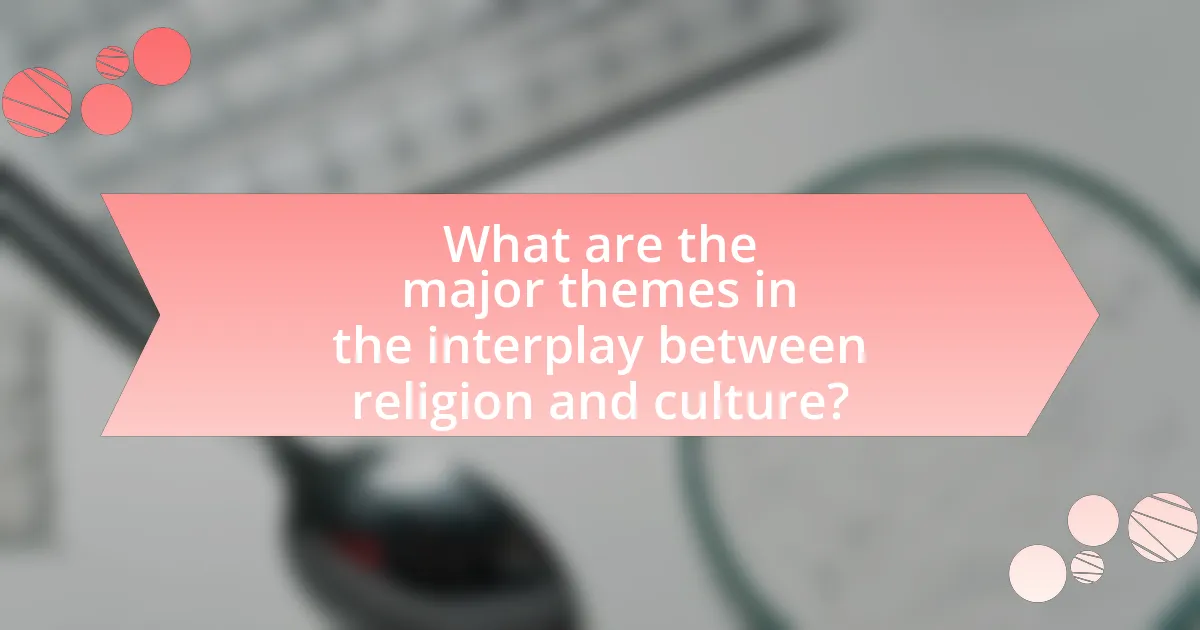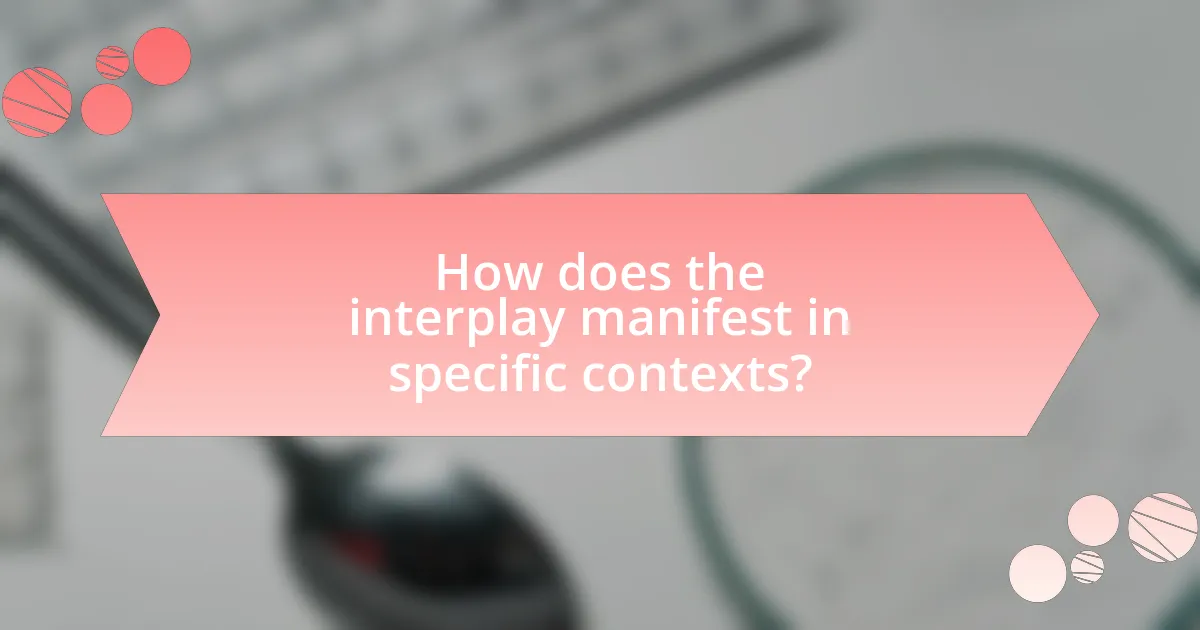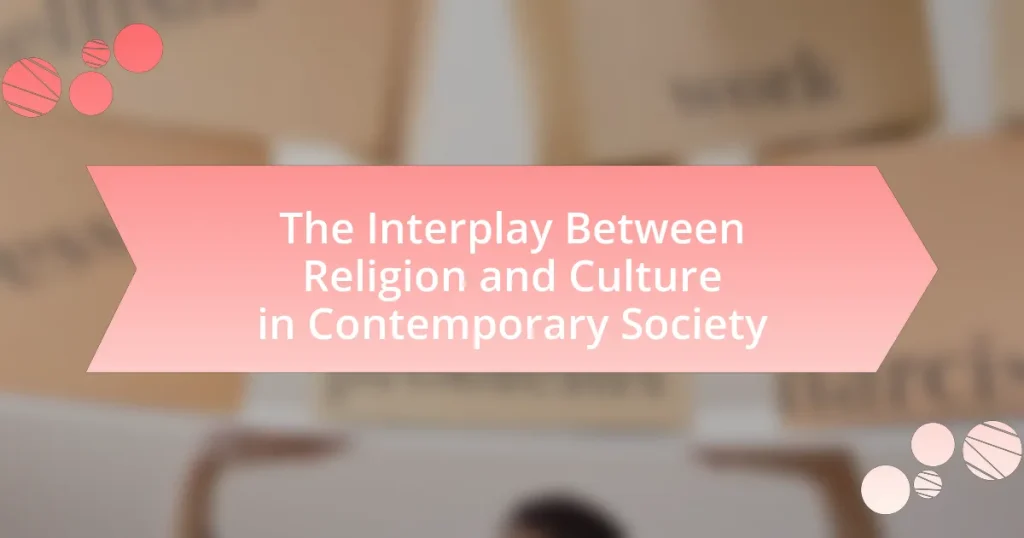The article examines the complex interplay between religion and culture in contemporary society, highlighting how they mutually influence each other. It discusses key elements of religion, such as beliefs, rituals, and moral codes, and their impact on cultural practices, as well as how cultural contexts shape religious expressions. The article also addresses the significance of understanding this relationship in today’s multicultural world, emphasizing its implications for social cohesion, identity formation, and conflict resolution. Additionally, it explores the effects of globalization and secularism on religious practices and cultural identity, providing insights into how communities can navigate cultural diversity and foster dialogue between different belief systems.

What is the Interplay Between Religion and Culture in Contemporary Society?
The interplay between religion and culture in contemporary society is characterized by mutual influence, where religious beliefs shape cultural practices and, conversely, cultural contexts affect religious expressions. For instance, in many societies, religious festivals are integrated into cultural celebrations, reflecting shared values and traditions. Additionally, the rise of secularism in various regions has led to a transformation in how religious practices are perceived and enacted, often resulting in a blending of spiritual and cultural identities. Research by sociologist Grace Davie highlights that in Europe, for example, the concept of “believing without belonging” illustrates how individuals may identify with religious traditions culturally while not actively participating in religious institutions. This dynamic demonstrates that religion and culture are not static but continuously evolve through their interactions in contemporary contexts.
How do religion and culture influence each other?
Religion and culture influence each other through a dynamic relationship where beliefs shape cultural practices and cultural contexts inform religious expressions. For instance, religious rituals often become embedded in cultural traditions, as seen in festivals like Diwali in Hindu culture, which incorporates both spiritual significance and cultural celebrations. Conversely, cultural values can shape religious interpretations, such as the adaptation of Christianity in various cultures, leading to diverse expressions of faith that reflect local customs. This interplay is evident in anthropological studies, such as those by Clifford Geertz, who emphasized the importance of understanding religion within its cultural context, demonstrating that neither can be fully understood in isolation from the other.
What are the key elements of religion that shape cultural practices?
The key elements of religion that shape cultural practices include beliefs, rituals, moral codes, and community structures. Beliefs provide a framework for understanding existence and guiding behavior, influencing cultural narratives and traditions. Rituals, such as ceremonies and festivals, reinforce communal bonds and transmit cultural values across generations. Moral codes derived from religious teachings establish ethical standards that govern social interactions and cultural norms. Community structures, often organized around religious institutions, foster social cohesion and collective identity, further embedding religious principles into cultural practices. These elements collectively influence how societies express their values, traditions, and social behaviors, as evidenced by the diverse cultural expressions found in various religious contexts worldwide.
In what ways does culture affect religious beliefs and practices?
Culture significantly influences religious beliefs and practices by shaping the values, rituals, and interpretations of faith. For instance, cultural norms dictate how religious texts are understood and applied, leading to variations in practices among different communities. In Japan, Shinto rituals are deeply intertwined with local customs, reflecting the culture’s emphasis on nature and community. Additionally, cultural celebrations often incorporate religious elements, as seen in the blending of Christmas traditions with local customs in various countries. This interplay illustrates that culture not only informs the expression of religious beliefs but also affects the communal and individual experiences of faith.
Why is understanding this interplay important in today’s world?
Understanding the interplay between religion and culture is crucial in today’s world because it shapes social dynamics, influences identity, and affects conflict resolution. This relationship impacts how communities interact, as cultural practices often stem from religious beliefs, which can either unite or divide societies. For instance, the Pew Research Center reports that religious affiliation significantly influences cultural norms and values, affecting everything from family structures to political ideologies. Recognizing this interplay allows for better dialogue and cooperation among diverse groups, fostering social cohesion in increasingly multicultural societies.
How does this interplay impact social cohesion and conflict?
The interplay between religion and culture significantly impacts social cohesion and conflict by shaping community identities and values. When religious beliefs align with cultural norms, they can foster a sense of belonging and unity among individuals, enhancing social cohesion. For instance, in societies where religious practices are integral to cultural traditions, such as in many Middle Eastern countries, shared beliefs can strengthen communal bonds and promote cooperation. Conversely, when religious differences clash with cultural expectations, they can lead to social fragmentation and conflict. Historical examples include the sectarian violence in Northern Ireland, where differing religious identities fueled tensions and divisions. Thus, the relationship between religion and culture is crucial in determining whether a society experiences harmony or discord.
What role does this interplay play in identity formation?
The interplay between religion and culture plays a crucial role in identity formation by shaping individual beliefs, values, and social practices. This dynamic influences how individuals perceive themselves and their place within society, as religious teachings often intertwine with cultural norms to create a cohesive identity framework. For instance, studies have shown that individuals who engage with both their cultural heritage and religious practices tend to develop a stronger sense of belonging and self-identity, as evidenced by research conducted by sociologists like Robert Putnam and David Campbell in “American Grace,” which highlights the correlation between religious involvement and social cohesion.

What are the major themes in the interplay between religion and culture?
The major themes in the interplay between religion and culture include identity formation, moral values, social cohesion, and conflict resolution. Identity formation is evident as religious beliefs often shape cultural practices and individual identities, influencing how communities define themselves. Moral values are transmitted through religious teachings, which guide ethical behavior and societal norms. Social cohesion is fostered as shared religious beliefs can unite individuals within a culture, creating a sense of belonging and community. Additionally, the interplay can lead to conflict resolution, where religious frameworks provide mechanisms for addressing disputes and promoting peace within diverse cultural contexts. These themes are supported by sociological studies, such as those by Emile Durkheim, who emphasized the role of religion in creating social solidarity, and Clifford Geertz, who highlighted the significance of cultural symbols in understanding religious practices.
How does globalization affect the relationship between religion and culture?
Globalization significantly influences the relationship between religion and culture by facilitating the exchange of ideas, beliefs, and practices across diverse societies. This interconnectedness often leads to the blending of cultural elements, resulting in the emergence of new religious expressions and practices that reflect a hybridization of cultural identities. For instance, the spread of global media and communication technologies allows religious groups to share their beliefs widely, which can lead to both the proliferation of new religious movements and the adaptation of traditional practices to fit contemporary cultural contexts. Research by sociologist José Casanova highlights how globalization can lead to both the revitalization of local religions and the rise of transnational religious movements, demonstrating that the interaction between religion and culture is dynamic and continually evolving in response to global influences.
What are the positive and negative effects of globalization on religious practices?
Globalization has both positive and negative effects on religious practices. On the positive side, globalization facilitates the exchange of religious ideas and practices, leading to greater interfaith dialogue and understanding. For instance, the spread of the internet allows diverse religious communities to connect, share beliefs, and promote tolerance, as seen in various online interfaith initiatives. Conversely, globalization can lead to the homogenization of religious practices, where local traditions are overshadowed by dominant global religions, potentially resulting in the loss of cultural identity. An example of this is the decline of indigenous spiritual practices in favor of more widespread religions, which can diminish the richness of local cultures.
How do local cultures adapt to global religious influences?
Local cultures adapt to global religious influences through syncretism, where elements of different belief systems merge to create new practices and traditions. For instance, in Latin America, indigenous beliefs have blended with Christianity, resulting in unique celebrations like Día de los Muertos, which incorporates Catholic elements with ancestral worship. This adaptation is often driven by the need for cultural preservation while engaging with global religious narratives, allowing communities to maintain their identity while embracing new ideas. Historical examples, such as the spread of Buddhism in East Asia, illustrate how local customs were integrated into the religion, demonstrating the dynamic nature of cultural adaptation in response to global religious influences.
What role does secularism play in contemporary society?
Secularism plays a crucial role in contemporary society by promoting the separation of religion from political, social, and educational institutions. This separation fosters an environment where diverse beliefs can coexist, allowing for pluralism and reducing religious conflicts. For instance, in countries like France, secularism is enshrined in law, ensuring that public spaces remain neutral regarding religious expressions, which helps maintain social harmony and equality among citizens of different faiths. Additionally, secularism supports the idea that government policies should be based on reason and evidence rather than religious doctrines, which is essential for democratic governance and human rights.
How does secularism challenge traditional religious practices?
Secularism challenges traditional religious practices by promoting a separation between religion and state, which diminishes the influence of religious institutions in public life. This shift is evident in various societies where laws and policies increasingly reflect secular values rather than religious doctrines, leading to a decline in the authority of religious leaders and institutions. For instance, in many Western countries, the legalization of same-sex marriage and the acceptance of diverse lifestyles contradict traditional religious teachings, illustrating how secularism can reshape societal norms and values.
What are the implications of secularism for cultural identity?
Secularism significantly influences cultural identity by promoting a separation between religious institutions and state affairs, which can lead to a more pluralistic society. This separation allows for diverse cultural expressions and identities to coexist without being dominated by a single religious framework. For instance, in secular societies like France, the emphasis on laïcité fosters an environment where multiple cultural identities can flourish, as seen in the celebration of various cultural festivals that are not tied to any specific religion. This pluralism can enhance social cohesion by encouraging mutual respect among different cultural groups, as evidenced by studies showing that secularism often correlates with higher levels of tolerance and acceptance of diversity.

How does the interplay manifest in specific contexts?
The interplay between religion and culture manifests in specific contexts through the integration of religious beliefs into cultural practices and vice versa. For example, in many societies, religious festivals such as Diwali in Hindu culture or Ramadan in Islamic culture are deeply embedded in the cultural identity, influencing social behaviors, community gatherings, and even economic activities. This integration is evidenced by the significant participation of non-religious individuals in these festivals, highlighting how cultural practices can transcend religious boundaries and foster communal harmony. Additionally, the influence of cultural norms on religious practices can be seen in the adaptation of rituals to align with local customs, such as the incorporation of traditional music and dance in religious ceremonies, which enhances community engagement and cultural continuity.
What examples illustrate the relationship between religion and culture in various societies?
The relationship between religion and culture is illustrated through various examples across societies. In India, Hindu festivals such as Diwali reflect cultural practices intertwined with religious beliefs, showcasing rituals that celebrate the victory of light over darkness. In the Middle East, Islamic practices shape cultural norms, such as the observance of Ramadan, which influences social behaviors and community gatherings. In Japan, Shinto beliefs are integrated into cultural traditions, evident in festivals like Matsuri, where religious rituals honor deities and ancestors. These examples demonstrate how religion informs cultural identity and practices, reinforcing community bonds and societal values.
How do festivals and rituals reflect this interplay?
Festivals and rituals reflect the interplay between religion and culture by serving as expressions of shared beliefs and values within a community. These events often incorporate religious themes, symbols, and practices that are deeply rooted in cultural traditions, illustrating how spiritual beliefs shape cultural identity. For example, Diwali, the Hindu festival of lights, not only celebrates the victory of light over darkness but also reinforces cultural practices such as family gatherings and communal celebrations, highlighting the integration of religious significance into cultural life. This blending of religion and culture is evident in various societies, where rituals associated with religious observances also promote social cohesion and cultural continuity, demonstrating their mutual influence.
What are the implications of religious art and literature on cultural expression?
Religious art and literature significantly shape cultural expression by providing a framework for moral values, community identity, and historical continuity. These forms of expression often reflect and reinforce the beliefs and practices of a religious community, influencing societal norms and behaviors. For instance, the Renaissance period saw a flourishing of religious art, such as Michelangelo’s Sistine Chapel, which not only conveyed theological themes but also impacted the cultural landscape by inspiring humanistic values and artistic innovation. Similarly, religious literature, like Dante’s “Divine Comedy,” has shaped cultural narratives and philosophical thought, illustrating the interplay between faith and human experience. Thus, religious art and literature serve as vital conduits for cultural expression, fostering a shared sense of identity and continuity within societies.
How do contemporary issues highlight the interplay between religion and culture?
Contemporary issues such as immigration, social justice movements, and secularism highlight the interplay between religion and culture by demonstrating how religious beliefs influence cultural practices and societal norms. For instance, the rise of multiculturalism in many societies has led to increased visibility of diverse religious practices, which in turn shapes cultural identity and community dynamics. Additionally, social justice movements often draw upon religious frameworks to advocate for equality and human rights, illustrating how religious values can inform cultural discourse. The ongoing debates around secularism and religious freedom further exemplify this interplay, as societies navigate the balance between maintaining cultural heritage and accommodating diverse religious expressions.
What role does religion play in social justice movements?
Religion plays a significant role in social justice movements by providing moral frameworks and mobilizing communities for advocacy. Religious organizations often serve as catalysts for social change, drawing on teachings that emphasize compassion, equality, and justice. For instance, during the Civil Rights Movement in the United States, leaders like Martin Luther King Jr. utilized Christian principles to inspire collective action against racial injustice, highlighting the intersection of faith and activism. Additionally, faith-based groups frequently engage in grassroots organizing, leveraging their networks to address issues such as poverty, discrimination, and human rights violations, thereby reinforcing the idea that social justice is a moral imperative rooted in religious beliefs.
How do cultural narratives shape religious responses to modern challenges?
Cultural narratives significantly shape religious responses to modern challenges by providing frameworks through which communities interpret contemporary issues. These narratives influence the values, beliefs, and practices that religious groups adopt in response to societal changes, such as technological advancements, social justice movements, and environmental concerns. For instance, the narrative of stewardship in many religious traditions has led to increased advocacy for environmental sustainability, as seen in initiatives like the Catholic Church’s “Laudato Si’,” which calls for action against climate change. This demonstrates how cultural narratives can mobilize religious communities to address modern challenges effectively, aligning their faith with contemporary ethical concerns.
What practical insights can be drawn from understanding this interplay?
Understanding the interplay between religion and culture in contemporary society reveals that cultural practices often shape religious expressions, and vice versa, influencing social cohesion and identity formation. For instance, in multicultural societies, religious diversity can lead to enriched cultural practices, fostering tolerance and dialogue among different groups. Research by Pew Research Center indicates that societies with higher levels of religious diversity tend to exhibit greater social cohesion, as shared cultural experiences can bridge gaps between differing belief systems. This insight underscores the importance of recognizing and valuing the dynamic relationship between religion and culture to promote social harmony and mutual respect.
How can individuals navigate cultural diversity in religious contexts?
Individuals can navigate cultural diversity in religious contexts by actively engaging in open dialogue and practicing empathy. Open dialogue allows individuals to share their beliefs and understand others’ perspectives, fostering mutual respect. Empathy enables individuals to appreciate the emotional and cultural significance of different religious practices. Research indicates that intercultural communication training enhances individuals’ ability to navigate diverse religious environments, as it equips them with skills to address misunderstandings and build relationships across cultural lines. For instance, a study published in the Journal of Intercultural Communication Research highlights that individuals who participate in intercultural training report increased confidence and competence in interacting with diverse religious groups.
What strategies can communities employ to foster dialogue between religion and culture?
Communities can employ strategies such as organizing interfaith dialogues, cultural exchange programs, and educational workshops to foster dialogue between religion and culture. Interfaith dialogues create a platform for individuals from different religious backgrounds to share beliefs and practices, promoting understanding and respect. Cultural exchange programs allow participants to experience and appreciate diverse traditions, enhancing mutual respect and reducing stereotypes. Educational workshops can focus on the historical and contemporary intersections of religion and culture, providing participants with knowledge that encourages open-mindedness and critical thinking. These strategies have been shown to reduce conflict and promote social cohesion, as evidenced by various community initiatives that have successfully bridged divides and fostered collaboration among diverse groups.
